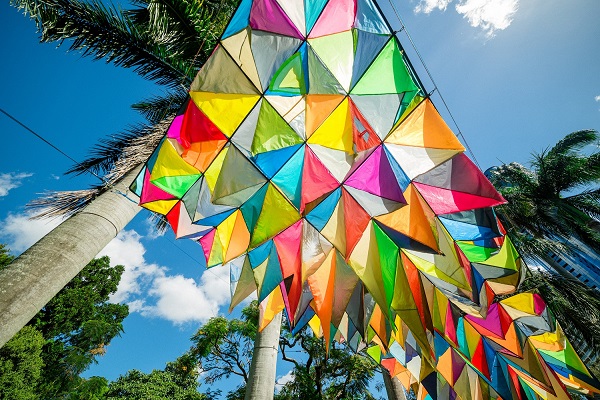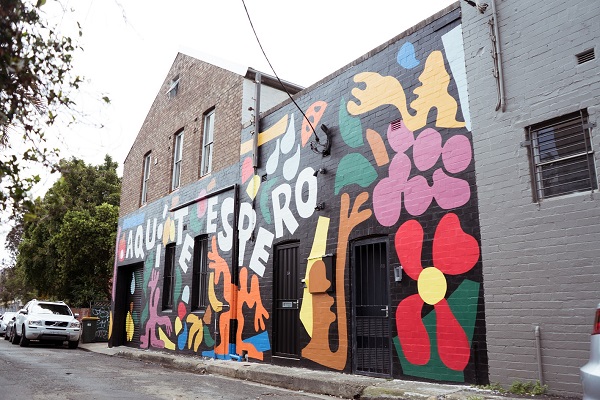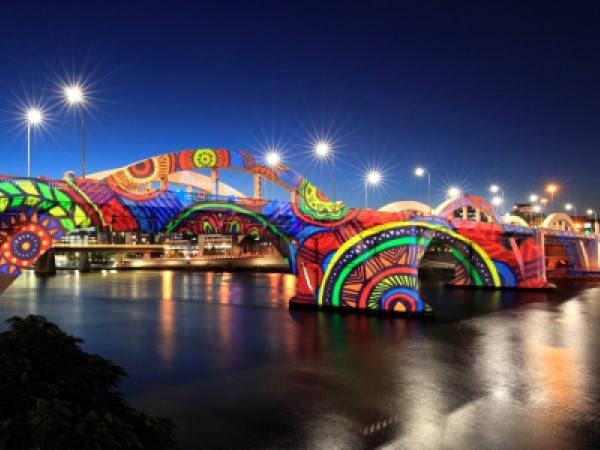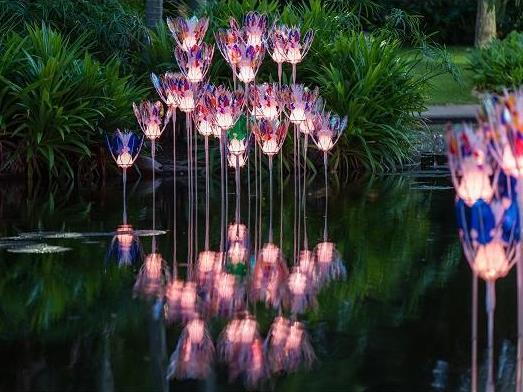Bastions of Light by Skunk Control, Botanica 2018. Image: Chelsea Sipthorp.
While some might be starting to rug up for winter, in sunny Brisbane autumn is just the right season to head outside as Brisbane City Council brings a variety of outdoor arts events to the city over the next few months.
‘Artists here are making really exciting political and social, critical and active work,’ exhibiting artist Sancintya Mohini Simpson told ArtsHub.
Botanica, an open-air exhibition at the City Botanic Gardens that’s now in its second year, runs from 10 to 19 May 2019 with a range of intriguing site-specific contemporary works, while Brisbane Canvas brings commissioned street art to locations across the city. Meanwhile, the Indigenous Art Program’s Shared Connections, curated by Blaklash Projects, a 100% Indigenous owned business, showcases Aboriginal and Torres Strait Islander contemporary arts ranging from weaving to animation in both indoor and outdoor settings.
Many of the events and artworks currently showing not only enliven public spaces, but also expose the city’s secrets, expressing vital truths about this country, its history, and its future.
Botanica – digging deeper
Simpson’s sound and film work Sugared Land/s is one of 12 installations featured in Botanica. The artworks are accompanied by live events including performances, talks, walks, and even one-on-one divination readings, all taking place in the picturesque settings of the City Botanic Gardens – which harbors countless stories of its own.
Simpson’s site-specific work centres around a large banyan tree planted in the 1870s by the garden’s then-curator, Walter Hill, whose experimentations with cane sugar led to sugarcane plantations spreading around Queensland. Sugared Land/s draws on Simpson’s own family’s history as indentured labourers transported from India to South Africa to work on sugar plantations, as well as the parallel histories of slavery, indenture and blackbirding in Queensland, and the role of the banyan tree as a symbol of healing and shelter in Hindu stories.
‘There’s so much to acknowledge and uncover about what’s happened here, what happened on this site,’ Simpson said. ‘I was interested in Queensland’s history of slavery, indenture and blackbirding, and how the site was such a catalyst for the industry here.’
‘I was interested in Queensland’s history of slavery, indenture and blackbirding, and how the site was such a catalyst for the industry here.’
Simpson’s brother and mother will be joining her in performances combining prose, song, and healing and cleansing rituals at the site, and on 18 May 2019, the artist will be in conversation with Aboriginal and South Sea Islander artist Joella Warkill – whose work is showing in the current Plantation Voices exhibition at the State Library of Queensland – and Fijian Indian Australian artist Shivanjani Lal to discuss the impacts of the sugar industry on their respective families and the histories they share.
‘There were a lot of parallel experiences of people being tricked and taken,’ Simpson explained, pointing to both commonalities across continents and differences such as the contexts of apartheid in South Africa, political coups in Fiji, and the White Australia Policy here. ‘The politics really did impact these communities and their freedom and where they could go from there … how these communities move forward, how they’re healing is something I’m interested in.’

Flourish.of.Tents by Georgina Humphries, Botanica 2018. Image: Dave Kan.
Other artworks in Botanica explore sustainability, materiality, and the construction of nationhood. Grace Lilian Lee’s A Weave Through Time applies traditional Torres Strait weaving techniques to various materials, while design and architectural studio Five Mile Radius’ Waste Piles forces us to reckon with our impact on the land.
Brisbane Canvas
Beyond the City Botanic Gardens, the Brisbane Canvas program has commissioned new works at a number of sites across the city and into the suburbs, supporting the local arts industry.
Walls, pillars and bridge structures come alive with eye-catching street art showcasing a range of styles and perspectives. From April to May look out for designs across the city at locations from Sunnybank to Bellbowrie.

Aquí Te Espero by Nadia Hernandez, Newtown, NSW. Image: Kurt Davies.
QUT graduate Nadia Hernandez, whose colourful and dynamic style has graced several public art commissions across Sydney, is working on the Dock Street site in South Brisbane. Hernandez’s work is informed by the political climate of her home country, Venezuela, and her diasporic experience.
Indigenous Art Program
From 1 May to 31 July, the Indigenous Art Program exhibition Shared Connections – curated by Troy Casey (Kamilaroi) and Amanda Hayman (Wakka Wakka/Kalkadoon) of Blaklash Collective – brings a range of exciting works to the museums and public spaces of Brisbane, as well as an event series including panel discussions and guided tours. Fourteen artists from different creative and cultural backgrounds offer their diverse responses to cultural heritage in the heart of Brisbane.

Brisbane’s William Jolly Bridge with projection of Riki Salam’s Creation Pathways (2019) as part of the Indigenous Art Program, Shared Connections. Image: David Sandison.
Jenna Lee, a Larrakia, Wardaman and Karajarri woman, uses the metaphor of plants thriving in hostile environments to explore survival in her work Invasive Native (2019) in Eagle Lane. The artwork was inspired by the artist discovering a collection of Australian native plants in London’s Kew Gardens.
Over on Edward Street, Dale Harding – a descendent of the Bidjara, Ghungalu and Garingbal peoples of Central Queensland – employs stencilling to examine untold histories. Taking inspiration from paintings around his Country in Carnarvon Gorge, his work features tools of the trade from boomerangs and spears to items used in his own studio. The work will be projected onto a building façade.
William Jolly Bridge will light up with projections designed by artists Rachael Sarra, Riki Salam, and Casey Coolwell. Coolwell, a Quandamooka, Nunukul woman from Minjerribah with links to Eulo and the Bini people of Bowen, looks at connections between different communities and countries in her striking work Connections (2019). The three artists will also be speaking about their work at the Yarning Up: Digital Designs event on 10 May 2019.
These interventions in public space challenge the conventional style of public artworks that lionise powerful men and nationalism. ‘Traditionally these public spaces are dominated by men and often white men, which is why the Brisbane City Council project [curated by] Blaklash is so exciting because it’s taking and reclaiming these public spaces,’ Simpson said. She also pointed to Fiona Foley, Judy Watson, Sally Gabori and Yayoi Kusama’s works at the Brisbane Magistrates Courts and Queen Elizabeth II Courts of Law – curated by Jay Younger – as examples of public art that offers a counterpoint to colonial patriarchal narratives.
‘History has been told through the lens of white male colonisers, so for me in my practice to have this platform where this history, where the stories of poor, lower-class brown women can be shared is so important,’ Simpson said.
Beyond the current program, Brisbane is home to imaginative, curious and engaging public art all year round. Visit the Brisbane City Council website to find out more.





